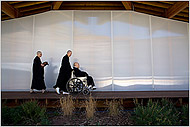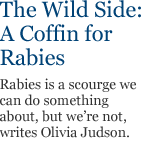Correction Appended
JEMEZ SPRINGS, N.M. — What would Buddha do?

Joshu Sasaki Roshi once dreamed of being a soldier; war and a brother’s death changed his path.
Every spring and fall, enlightenment-seekers from all over come here to find out, converging for arduous weeklong retreats at the Bodhi Manda Zen Center in a red rock canyon among the thermal springs and Indian pueblos west of Santa Fe.
Dressed in black robes, they strive to live in the moment and awaken to the oneness of everything by rising at 3 a.m. for 18-hour sessions sitting lotus-style in the zendo, or meditation hall, eating communal vegan meals in silence, chanting and taking restorative dips in the hot pools.
But mostly they come to practice with an impish, smooth-faced Japanese monk, Kyozan Joshu Sasaki Roshi, a 100-year-old Rinzai Zen master, one of the oldest in the world, who tells followers, “Excuse me for not dying.”
Forty-five years after arriving in the United States at 55 with no English but two dictionaries tucked into his robe sleeves, Roshi, or “venerable teacher,” the honorific by which he is widely known, is still going strong, traveling from his base in California to more than a dozen Zen centers he opened or inspired around the country, ordaining priests — more than 25 to date — and challenging students with Buddhist-style tough love.
“Enlightenment? I don’t like this subject at all,” Joshu Roshi said, speaking in Japanese through his interpreter and chuckling softly in a rare interview. “I bet you can find all sorts of different descriptions of it in the bookstore.”
He scolded Americans as too attached to their way of life, attachments in Buddhism being seen as a cause of suffering.
“That’s why I am always angrily yelling at my students,” he said, “‘If you’re attached to American democracy, you’ll never become the leaders of the free world again.’”
His followers grapple with his complexities. “He can’t give you anything,” said Seiju Bob Mammoser, a longtime student who is now abbot of the Albuquerque Zen Center. “You have to find it for yourself.”
From its postwar embrace by American hipsters, Zen Buddhism exploded in popularity in the 1970s, with about 75 major Zen centers now operating around the country, said T. Griffith Foulk, professor of religion at Sarah Lawrence College.
Dr. Foulk, a Buddhist monk and editor of a project to translate ancient Soto Zen works, called Joshu Roshi a significant figure in the Rinzai school, a branch somewhat less populous than Soto, with mostly obscure differences between them.
Like other masters, Dr. Foulk said, Joshu Roshi traced his lineage in the dharma, or Buddhist body of knowledge, through centuries of teachers with a claim of authority to the Buddha, or Awakened One, himself, a figure named Siddhartha Gautama said to have been born around 563 B.C. in what is now Nepal.
Born to a farming family in Sendai in northern Japan, Joshu Roshi grew up before World War I dreaming of becoming a soldier.
“I remember how I thought that Germany had become a really, really strong country and that they had aeroplanes,” he said through his interpreter, Giko Rubin, a Buddhist priest from Albuquerque by way of Brooklyn. But the war changed his mind. Then his older brother fell ill and died. “Perhaps that was one of the first causes for me wanting to become a monk,” he said.
As a 14-year-old novice, he was asked by his abbot, “How old is the Buddha?” His ready answer stunned his master and put him on the path to early priesthood: “Buddha’s age and my age are the same.”
In 1962, two Zen students in California wrote to his temple in Japan seeking a teacher, and Joshu Roshi was selected. He arrived with little more than a pair of dictionaries, Japanese to English and English to Japanese. He set up in a garage in Los Angeles until founding what became his lead temple, the Rinzai-ji Center on Cimarron Street, where he and his wife still live. By 1970, he had created a Zen training center from a former Boy Scout camp at Mount Baldy in the San Gabriel Mountains. In 1972, a supporter sought to draw him to New Mexico. “You find hot springs, I come,” he said. She did — and he did, founding Bodhi Manda, or enlightenment circle.
Perhaps his most prominent student has been the songwriter and poet Leonard Cohen, who studied here and spent much of the ’90s cloistered at Mount Baldy, re-emerging in a burst of creativity.
Joshu Roshi assigns each student a koan, a baffling question pointing at some ultimate truth — “How do you experience God when you hear the sound of my stick?” was one — meets privately with each student four times a day and offers a daily lecture, or teisho, from a high seat in the Center of Gravity Hall.
“Buddhism does not acknowledge the existence of a world-creating God,” he said in one recent talk. “But having said that,” he added, “Buddhism does not at the same time reject the existence of God.”
Among those at a November retreat, paying $450 for a week’s dorm bed and board, was Jodo John Candy, 61, a monk and retired parks worker from the Seattle area who has come twice a year since 1987. “When the bell rings, you ring,” Mr. Candy said.
Another regular, Dr. Lou Trost, 55, a family practitioner from Albuquerque who was raised Presbyterian and is married to a doctor who practices the Baha’i faith, said he was seeking answers to a professional problem: how to live in the moment focusing on patient care while distracted by mundane details.
“It’s easy,” Joshu Roshi said later. “Just shine like the light of the sun shines all the time.”
Shodo Lamson, 32, a school property manager from Boulder, Colo., also visits often. “To be able to share a room with someone a hundred years old who has spent his time deepening his relationship with the universe — it’s chronically intense,” Mr. Lamson said.
The monastery is run by Jiun Hosen Osho, 56, a former Montreal medical technologist raised Roman Catholic who gravitated to Buddhism and Joshu Roshi 30 years ago and now aids him in his travels. Her deputy here is an 18-year-old Albuquerque high school graduate, Emily Robinson, who has put off college and advanced so quickly that she has been offered priesthood, though she is now hesitating. “I always thought I wanted to be ordained until the day I found out it was available to me,” she said.
Any or all of his followers are potential successors, Joshu Roshi said, but he is not ready to decide. “It’s very complicated,” he said. “There are things that I cannot announce.”
But he said, “If someone would turn up who can totally abandon their ego and manifest that zero state that is neither subject nor object and that is a complete unification of plus and minus, then I think I would make them a successor.”
Then, he said, “I could finally take a break and be happy about that.”
Correction: December 12, 2007
An article on Sunday about a 100-year-old Zen master in











